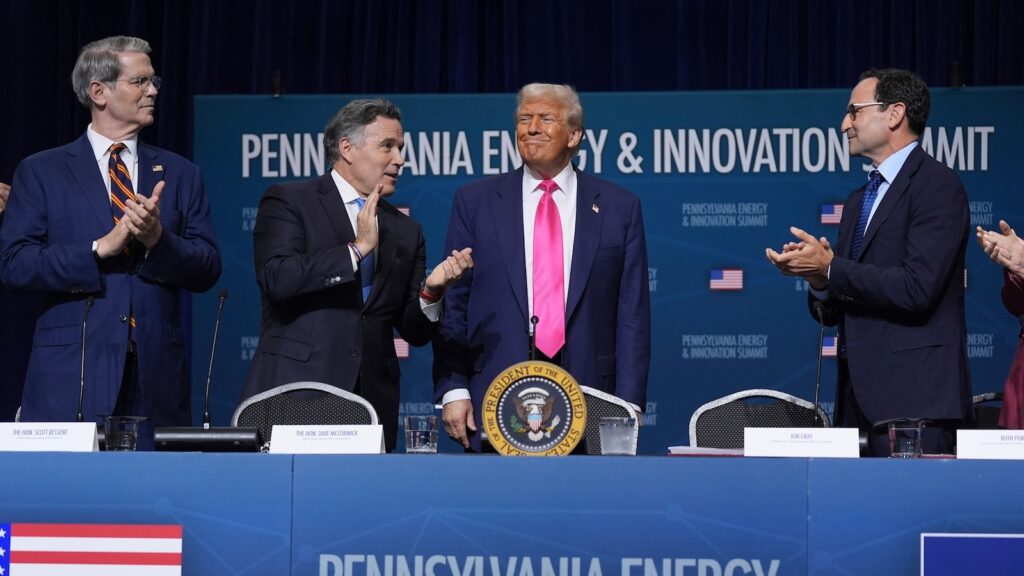President Donald Trump’s tariffs tanked markets and unleashed recession forecasts when the president unveiled sweeping levies little more than 100 days ago. Now, as Trump continues to tout the policy, the economy is humming along and Wall Street is responding to each new tariff with a shrug.
A recent round of tariff threats has added a new layer of uncertainty, but the monthslong track record affords economists an opportunity to evaluate what the tariffs have yielded so far.
Analysts who spoke to ABC News credited the tariffs for delivering higher-than-expected tax revenue and helping to elicit some commitments from companies bent on investing in new production in the U.S.
But, some analysts cautioned, those company commitments carry a long time horizon and wiggle room for firms to renege upon the spending as the tariff policy fluctuates. Meanwhile, tariffs have started to push up some prices, risking a bout of inflation that could hurt consumers and disrupt the economy, they said.
Trump has rolled back many of his steepest tariffs over recent months, including a sky-high levy on China, the top source of U.S. imports. In recent days, however, Trump announced plans to slap tariffs as high as 50% on dozens of countries, including 25% tariffs on top U.S. trade partners such as Japan and South Korea.
In all, consumers currently face an effective tariff rate of 20.6%, the highest since 1910, the Yale Budget Lab found this week.
The Trump administration touts tariffs as part of a wider set of “America First economic policies,” which have “sparked trillions of dollars in new investment in U.S. manufacturing, technology, and infrastructure,” according to the White House’s website.
In theory, levies on imports incentivize firms to build manufacturing in the U.S. as a means of averting the tax burden.
Scores of companies have pledged new investment in the U.S., including tech giants Apple and Nvidia, pharmaceutical companies Merck and Johnson & Johnson as well as automakers Hyundai and Stellantis, the White House says.
“The whole idea is to encourage reshoring of manufacturing and change the balance of trade. That could all have some positive impact,” Morris Cohen, a professor emeritus of manufacturing and supply chains at Duke University, told ABC News.
Companies face the choice of making costly, long-term investment decisions amid Trump’s on-again, off-again tariff policies, which the White House has altered numerous times since Trump took office, some analysts said.
A pair of court rulings in May thrust some of the tariffs into legal limbo, adding another layer of uncertainty as federal appeals court judges determine whether a major swath of the policies pass legal muster.
“The companies making promises are trying to politically deal with Trump,” Matias Vernengo, a professor of economics at Bucknell University, told ABC News, adding that he expects many firms will ultimately fall short of their commitments.
“It would be nice if he announced a tariff policy and stuck to it. But that’s not what’s happening,” Vernengo added.
The Trump administration has rebuked criticism of its tariff approach, saying the flexibility affords White House officials leverage in trade negotiations with countries targeted by the levies.
President Donald Trump holds up a chart while speaking during a “Make America Wealthy Again” trade announcement event in the Rose Garden at the White House, April 2, 2025.
Chip Somodevilla/Getty Images
The tariffs, meanwhile, have yielded a burst of tax revenue as importers to pay the federal government when they bring targeted goods into the U.S. The U.S. recorded about $27 billion in tariff-related tax revenue last month, bringing total payments so far this year to more than $100 billion, Treasury Department data showed.
Mark Zandi, chief economist at Moody’s Analytics, said tariff revenue could exceed $300 billion by the end of 2025, which would amount to nearly 1% of U.S. gross domestic product. That revenue could help ease government deficits, some analysts noted.
“The tariff revenues are more substantial than I anticipated at the start of the year,” Zandi said, noting that tariff levels had remained higher than he expected.
Still, Zandi voiced skepticism about the staying power of the tax payments.
“It would not be prudent for lawmakers to count on this revenue in the future, as it is unclear whether the tariffs will remain in place given they may be found to be illegal or future Presidents may decide to lower or eliminate them under executive order,” Zandi said.
Meanwhile, the U.S. economy so far has defied analysts’ fears of a large, tariff-induced price spike. Still, tariffs contributed modestly to the rise of inflation last month, analysts previously told ABC News, citing the price hikes in product categories made up primarily of imports.
Consumer prices rose 2.7% in June compared to a year ago, matching economists’ expectations but marking an uptick from a month earlier. Still, the inflation rate clocked in below the 3% recorded in January, the month Trump took office.
The price of toys — a product dependent almost entirely on imports — increased six times faster in June than it had just two months prior. Commonly imported products like clothes, furniture and bed linens were also among the goods that jumped in price.
Vernengo, of Bucknell University, said tariffs would likely push up inflation for a temporary period, putting pressure on the Fed to keep interest rates elevated and in turn risk an economic slowdown.
“Prices will go up as Trump imposes tariffs. Then, as tariffs are established and prices adjust themselves, they will stop growing,” Vernengo said. “It’s the Fed’s reaction that will matter more in my view than the tariffs.”


